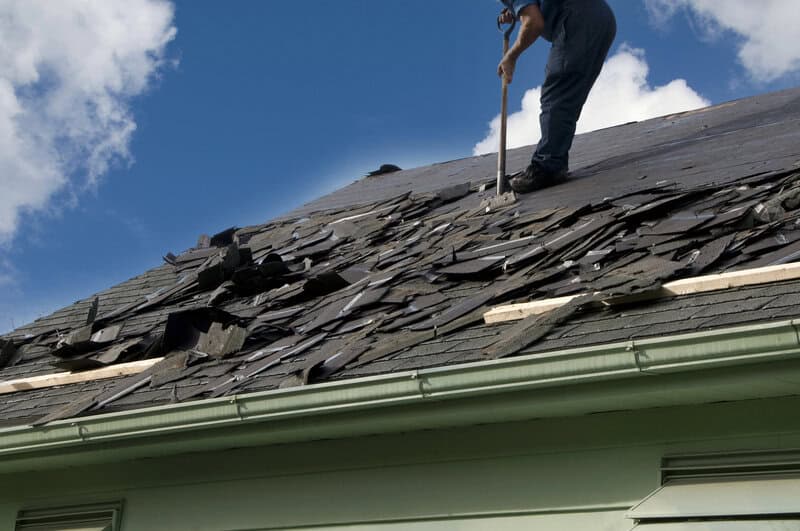
Your new roof, installed by a licensed roofing contractor, can last for at least 20 years or longer, depending on your attention to annual roofing maintenance and repairs. The roof takes a beating due to its exposure to the sun’s harmful UV rays, not to mention debris that falls on it – or blows across it – during storms.
Annual maintenance and routine repairs are essential to get the most out of your roof and to minimize more significant repair costs or unnecessarily frequent roof replacements.
6 Common Roofing Repairs That Increase Your Roof’s Lifespan
Here are six common roofing repairs to consider if you haven’t had an inspection or roof replacement in the past year or two.
Schedule a roof inspection & maintenance
While not a specific repair, scheduling a professional roof inspection every year or two is a wise idea. These are very affordable and can save you thousands of dollars by catching small roofing needs before they grow to less affordable proportions.
Your roof protects your house and its occupants from the elements. So, any leaks working their way into the interior wall spaces or underneath the foundation may not reveal themselves until tremendous damage is done.
During a roof inspection, we:
- Walk around the perimeter of your home, inspecting the roof, gutters, and downspouts. We’ll note anything suspicious, including signs that the drainage system is compromising your foundation.
- Walk every square inch of the roof, looking for missing or broken shingles, tiles, damaged flashing, etc.
- Assess the roof’s surface and feel for any sponginess or irregularities that indicate issues with the roof deck or underlayments.
- Clear off any debris.
- Visually inspect the flashing and seals surrounding any roof penetrations, like skylights, solar tubes, chimneys, vents, HVAC equipment, and so on.
- Determine whether your roof vents are adequate for the roof size and ensure they’re free and clear of debris.
- Clean or address any roof discolorations caused by moss or algae.
- And more.
Based on our inspection, we make recommendations about current or upcoming repair needs. Proof of these inspections and documentation of related repairs can go a long way if/when you need to file a homeowner’s insurance claim.
Repair or replace damaged or missing roof materials
It’s easy to notice damaged or missing shingles or tiles when you find pieces of them lying around the perimeter of your home or the yard. You may even notice damaged or missing roof materials when you look up at the roof.
However, there may be damaged roofing materials you can’t see without walking the square footage of your roof or without the experienced eye of a roofing contractor. The longer these items go without repair, the more damaged they become and the more vulnerable your roof will be.
Some of the most common items we repair or recommend replacing during a roof inspection or routine maintenance appointment are:
- Shingles or tiles (which can crack, chip, lift, shrink, or blister).
- Seals around roof penetrations (particularly skylights, chimneys, and vents).
- Flashing.
- Drip edges.
The sooner you replace these, the smaller the repair bill, the lower your risk of a future roof leak, and the longer you can go without a roof replacement.
Minor leaks
Life feels like it gets busier every year, and the list of to-dos grows along with that. However, any suspicious signs of potential leaks should be a top priority on that list. Roof leaks, however minor they may seem, are doing damage.
First, leaks compromise the roof’s integrity. The more water infiltrates the layers of your roof’s anatomy, the weaker and more vulnerable they become. Second, those same leaks can lead to water damage inside your home. Bay Area homes with persistent, unrepaired leaks are more likely to have black mold and mildew growth, which poses risks to both the structural materials and the occupants’ respiratory health.
Signs of leaks include:
- A dripping or damp ceiling during a rain storm.
- Soft, spongy, or sagging areas of the ceiling.
- Stains on the ceilings or exterior walls (often where the wall meets the ceiling), can appear grey, brown, yellowish, or a rusty color.
- Electrical shorts (which could be caused by tripping breakers when leaks or excess moisture make contact with electrical wiring in the attic or exterior walls).
- Visible mold or mildew, usually on ceilings or where exterior walls meet the ceiling.
- A damp or musty smell.
Never ignore these signs. Again, homeowner’s insurance companies are increasingly strict about payouts. Any indication that you waited too long to register your claim can void your policy or reduce the total payout.
Cleaning, fixing, or repairing gutters and downspouts
The gutters and downspouts are essential players in any roofing system. Without them, water doesn’t drain properly from the roof and away from the home’s foundation.
Like everything else, gutters and downspouts require routine maintenance to continue performing as designed through their lifespan. Depending on the material, size, shape, and quality of installation, gutters and downspouts can:
- Rust or corrode.
- Become blocked by debris.
- Separate at their seams or connection.
- Come apart from the roof/exterior wall, preventing them from collecting water properly.
In some cases, a home’s original gutter and downspout system may not have been designed adequately for the size or slope of the roof, which can also cause problems.
Keeping the gutters and downspouts clear, cleaning them annually, and ensuring they’re sized/installed properly are all part of the common roofing repairs task list.
Moss or algae-covered roof sections
Roofers around the Bay Area are always on the lookout for any roof discolorations, indicating that moss, algae, or mold are a problem. If your roof doesn’t get enough direct sunlight, it’s at risk of growing moss, algae, or mold, all of which pose a risk to roofing materials.
These organisms feed on organic matter, and your roof materials have much to offer. Over time, this will lead to rot and roof leaks, not to mention potential moisture issues in the attic, structural components of your home, and mold/mildew growth in your living spaces.
If we notice stains or discolorations, we’ll isolate the source, clean and sanitize it, and keep you informed if further action is required.
Tree pruning and maintenance
While trees aren’t part of the roof, trees large enough to overhang a roof are one of the roof’s greatest threats. Broken tree limbs and branches are a leading cause of roof damage, leading to roof leaks. Keeping overhanging limbs trimmed and removing dead or unhealthy limbs/branches/trees protects your trees from unnecessary damage.
Schedule An Inspection And Routine Roof Repairs With PCR
Is your roof overdue for an inspection? Most common roofing repairs or maintenance are beyond the DIY scope. Contact Pacific Coast Roofing to schedule an inspection. We’ve provided reliable and competitively priced roofing repairs and services for over 40 years.

